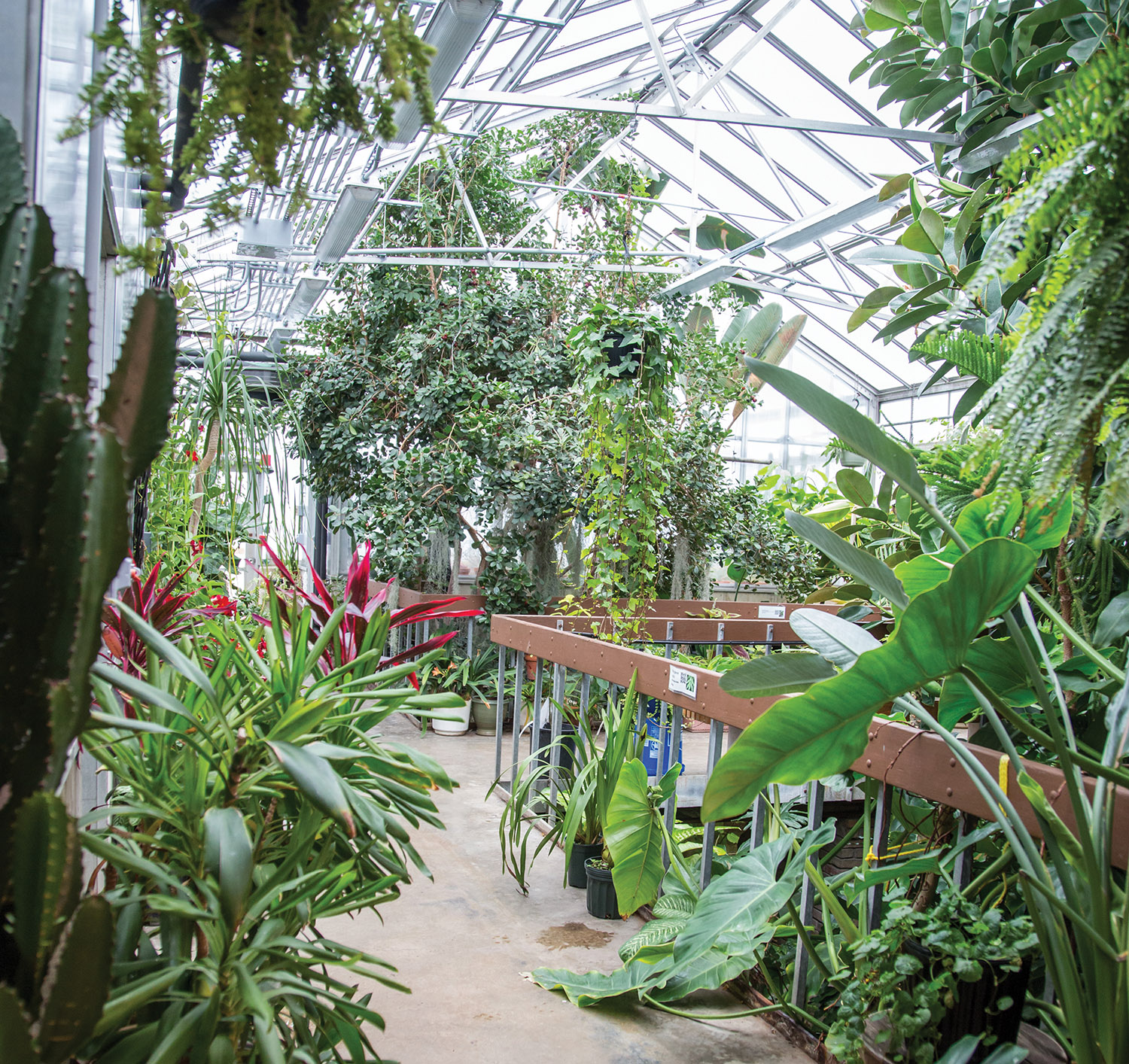Herrick Conservatory
Home to a diverse array of plantsÔÇöand some fishÔÇöthe facility is also filled with people. Students and faculty members from the biological sciences department conduct research there, students from other majors come to study and sketch, and student members of the Herrick Conservatory and Sustainability Club help with its upkeep.
ÔÇťWe do a lot of outreach, too,ÔÇŁ says Melissa Davis, BS ÔÇÖ04, MS ÔÇÖ10, horticultural facilities director since 2014. High school students with disabilities explore careers and gain job training there through the conservatoryÔÇÖs partnership with programs like the ║┌┴¤│ď╣¤═° Transition Collaborative and the Center for Career Services. And members of the community often visit for a guided tour or a refreshing retreat.
This past year, construction workers , attached to the north side of Cunningham Hall, as part of the extensive renovations to the Science Mall that were completed in fall 2017. In the summer, they added on 1,500 square feet to the greenhouse complex to house new faculty research.
ÔÇťWeÔÇÖve reglazed the entire structure with double-walled, insulated polycarbonate panels that provide diffused light,ÔÇŁ says Ms. Davis. ÔÇťAnd weÔÇÖve implemented new environmental control systems throughout, so everythingÔÇöheating, cooling, vent opening, misting systems, lightingÔÇöis controlled by automatic settings. These innovations have improved our ability to accurately control the buildingÔÇÖs environment and have contributed to the campusÔÇÖs energy conservation goals.ÔÇŁ
The Herrick Conservatory, which was founded in 1978, is named for emeritus faculty members, Dr. J. Arthur and Margaret Herrick, who were longtime benefactors of ║┌┴¤│ď╣¤═°. The couple, who both died in 2008, gave over 2.4 million dollars in their lifetimes to help support the facility and an endowed chair in plant conservation biology.
Ms. Davis gave us an enthusiastic tour of the building, which is divided into several areas that provide specialized growth conditions for the permanent plant collections, as well as spaces for projects that support sustainability:
CONSERVATORY
The large central space (see photo at top of page) is defined as a conservatoryÔÇöa greenhouse with seating to welcome visitors. It consists of two large sunken areas housing tree-sized plants, including a giant rubber tree and a strawberry guava tree that have been there 30 years, as well as banana trees, a papaya tree, a chocolate tree, other tropical plants and a koi pond. Greenhouse bays branching off from the main space contain specialized collections that are open to visitors, as well as faculty research areas that are not open to the public.
GREENHOUSE COLLECTIONS
Diversity of flowering plants: With over 250,000 different types of flowering plants in the world, the collection in this bay gives students an opportunity to observe not only the bright-colored blooms on display that we typically recognize as flowers, but also those with no color.
Cactus and succulents: In this bay, the temperature and humidity are preset to be higher and drier than other areas for the comfort of the plants. The collection houses drought-resistant (xeric) plants, including barrel cactus, prickly pear cactus, century plant (Agave americana), ghost plant, many Aloe species and Haworthia, small succulents from Southern Africa. (See photo above.)
Tropical plants: This collection displays tropical plants from around the world, including coconut palm, cinnamon, pomegranate, and citrus plants such as limes, lemons, oranges and grapefruits.
Ferns and humidity-loving plants: An ultrasonic fogging machine adds humidity to this bay, which includes flowering plants that enjoy moist growing conditions, like palms and orchids. It also houses a variety of spore-bearing vascular lower plants like ferns, whisk ferns and horsetails.
Carnivorous plants: This collection includes Venus fly traps, tropical pitcher plants, sundews, and related examples of the native sundews that grow six miles from campus in the 140-acre , a state nature preserve.
BREEZEWAY
Shelves lining the recently reglazed corridor connecting Cunningham Hall with the Herrick Conservatory hold student projects for undergrad courses in biological sciences and are accessible even when the conservatory is closed. (See photo above.)
WEATHER STATION
A weather station on a mast high above the greenhouse monitors conditions in order to protect the structure. For example, it signals the environmental control systems to close vents if itÔÇÖs raining hard.
SUSTAINABILITY PROJECTS
Aquaponic growth system: To promote sustainability, this project illustrates aquaponics, the combination of aquaculture (raising fish) and hydroponics (the soil-less growing of plants) that grows fish and plants together in one integrated system.
Seed collecting: Greenhouse staff have collected over 100 different species of viable native plant seeds so far. And they gathered seeds from bedding flowers and plants in ║┌┴¤│ď╣¤═°ÔÇÖs community garden this past fall to plant in the spring. (See photo above.)
Rain barrels: The biological sciences department partnered with the art department to recycle, repurpose and decorate rain barrels, which are used by Ms. Davis to promote sustainability throughout Northeast Ohio. The greenhouse also collects water in rain barrels for carnivorous plants and fish that canÔÇÖt tolerate the chlorine in tap water.
HERBARIUM
Herbaria are museum collections of pressed, dried plant specimens that function to identify plants, document changes in flora and provide the basis for botanical research. (See photo above.)
Room 128 in Cunningham Hall holds the Tom S. and Miwako K. Cooperrider KSU Herbarium, named for faculty members who established this facility in the 1950s (and helped train Ms. Davis). Originally founded in 1921, it currently holds approximately 81,000 accessionsÔÇöprimarily flora of northeastern Ohio, but from other areas as wellÔÇöand is the fourth largest in the state.
The herbarium is only open by appointment for botanical research, but the collections have been databased and are now being digitized into a virtual herbarium.
The Herrick Conservatory is open weekdays from 9-5. For tours and information, contact Melissa Davis, horticultural facilities director, mdavis7@kent.edu, 330-672-2469. Visit the HerbariumÔÇÖs digital collections at www.kent.edu/biology/herbarium.
